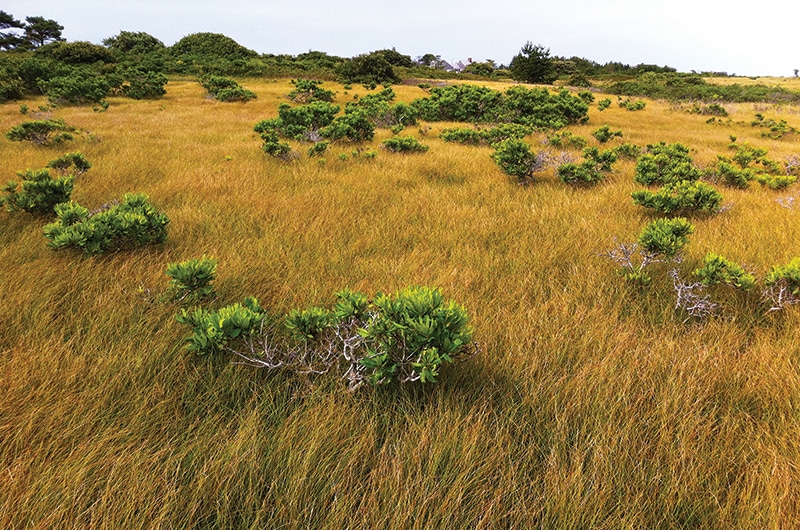by Dr. Sarah Treanor Bois
Director of Research & Education at the Linda Loring Nature Foundation
For people and plants, Nantucket can be a formidable place to call home. Only the hardiest souls can endure the wind, salt spray, and isolation all year, but those that can are rewarded with the summer sun and temperate shoulder seasons. Our well-drained, nutrient-poor, sandy soils have created highly specialized habitats known for sparse trees and drought-resistant grasses, shrubs, and wildflowers. The diversity of life native to Nantucket are a special lot and should be reverenced as such.

In a recent report, the New England Wildflower Society used botanical data, historical records, and cultural information to assess the current status of the New England flora, highlighting “Habitats in Trouble.” It should be a badge of pride for Nantucketers that two of the five habitats highlighted as “at risk” are prevalent on Nantucket and already under protection; the sandplain grasslands/heathlands and estuarine marshes.
SANDPLAIN GRASSLANDS AND HEATHLANDS
Nantucket has some of the largest expanses of intact sandplain grassland and heathland habitat. With much of this landscape lost to development up and down the Atlantic coast, almost 90% of the world’s sandplain grassland occurs on Nantucket, Martha’s Vineyard, Cape Cod National Seashore, and a slice of Long Island. We know these habitats for their Black Huckleberry, sweet Low- and Highbush Blueberries, fragrant Northern Bayberry, and Little Blue-stem grasses rolling in the winds. These plant communities are host to a number of regionally and globally rare species as well, including the Eastern Silvery Aster, Nantucket Shadbush, and the spectacular New England Blazing Star, among others.
While plants are the cornerstone for ecosystems everywhere, sandplain grasslands and coastal heathlands support a diversity of life found in few, if any, other locations. Northern Harrier hawks and Short-eared Owls hunt and nest in the grassland/shrub mix. Grasshopper sparrows eat, sleep, and nest on the ground – impossible to do off-island where skunks, raccoons, and other nest predators are about. Grasslands and heathlands are host to a multitude of insect fauna including at least 19 rare species. This includes important pollinators, dragonflies, butterflies, and moths.
WHAT’S BEING DONE?
Nantucket was ahead of its time in creating so much open space, and, in doing so, it created some of the best examples of sandplain grassland and coastal heathland on earth. We are lucky to be on the side of preservation and maintenance rather than restoration and reclamation seen in other areas.
Aside from development, lack of management and fire suppression have been the primary threats to these early successional habitats in other areas. Nantucketers have become accustomed seeing smoke in the heathlands along the south shore during the shoulder seasons. These spring and fall management burns are one way these habitats are maintained. Mowing, tilling, and harrowing are other tools in the toolbox used to improve grassland habitat.
Non-native invasive plants such as Spotted Knapweed, Scotch Broom, and Black Swallowwort also pose a threat to native landscapes. Organizations like the Invasive Plant Species Committee of the Nantucket Biodiversity Initiative organize plant pulls in sensitive areas and promote native plantings on private and public properties.
WHAT CAN YOU DO?
Here are a few steps that you can take locally and in your own home to support native species:
- Visit a sandplain grassland and heathland property and see it for yourself. The island’s south coast is the place to be for these habitats with many Nantucket Conservation Foundation and Nantucket Land Bank properties open to the public. The Linda Loring Nature Foundation offers weekly plant and nature walks on its heathland/grassland Eel Point property. And Nantucket Walkabout guide Peter Brace has some tours that include them.
- Support your favorite island conservation organization. Many of these organizations work hard to acquire, maintain, manage, and study these important habitats. Help their cause for your own enjoyment of these amazing places.
- Plant native where you can. What we plant in our yards determine what will populate our yards. This small effort can help increase native bird and pollinator diversity including bees and butterflies.